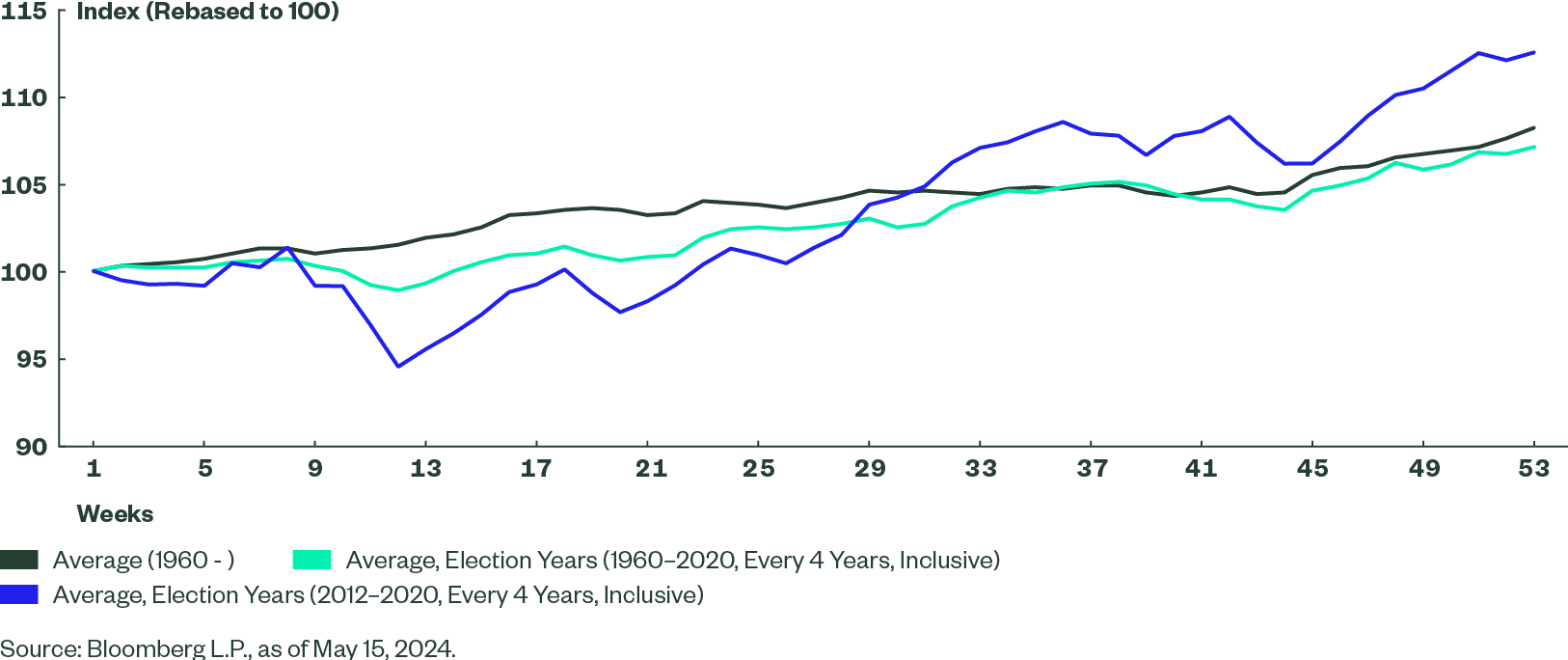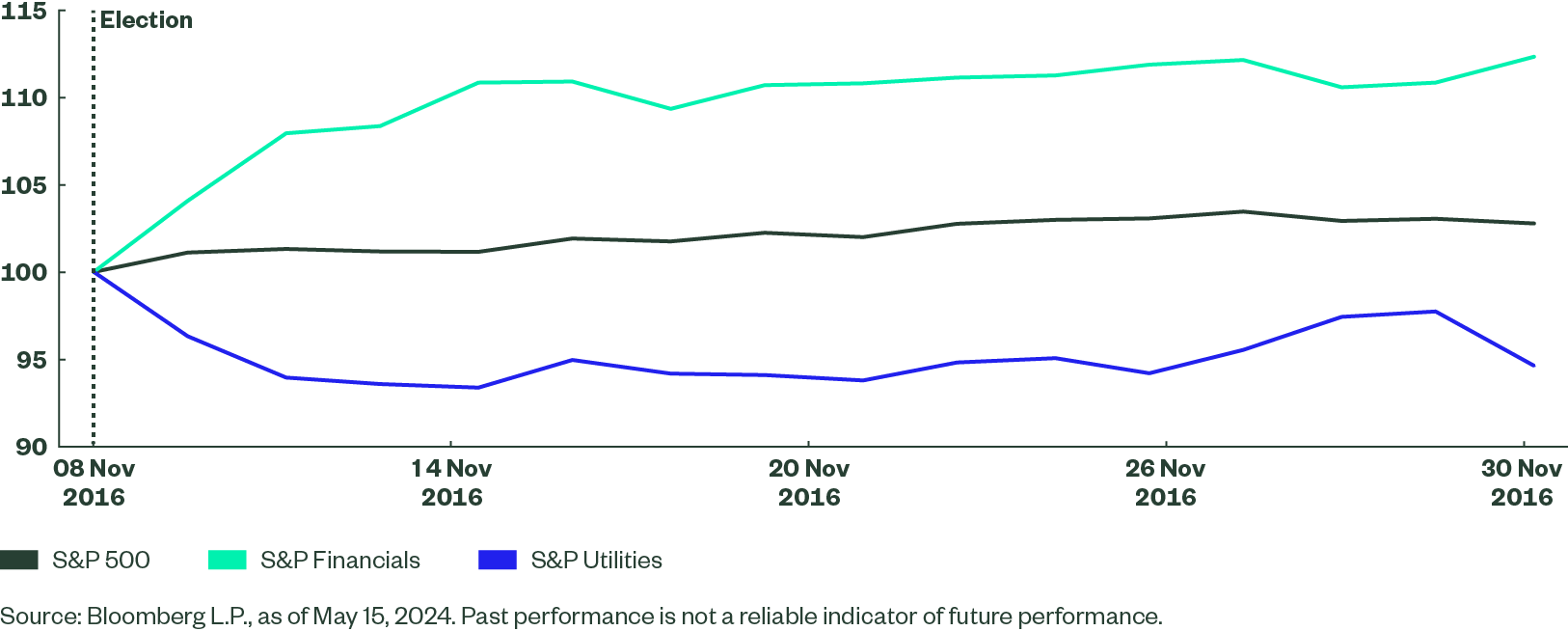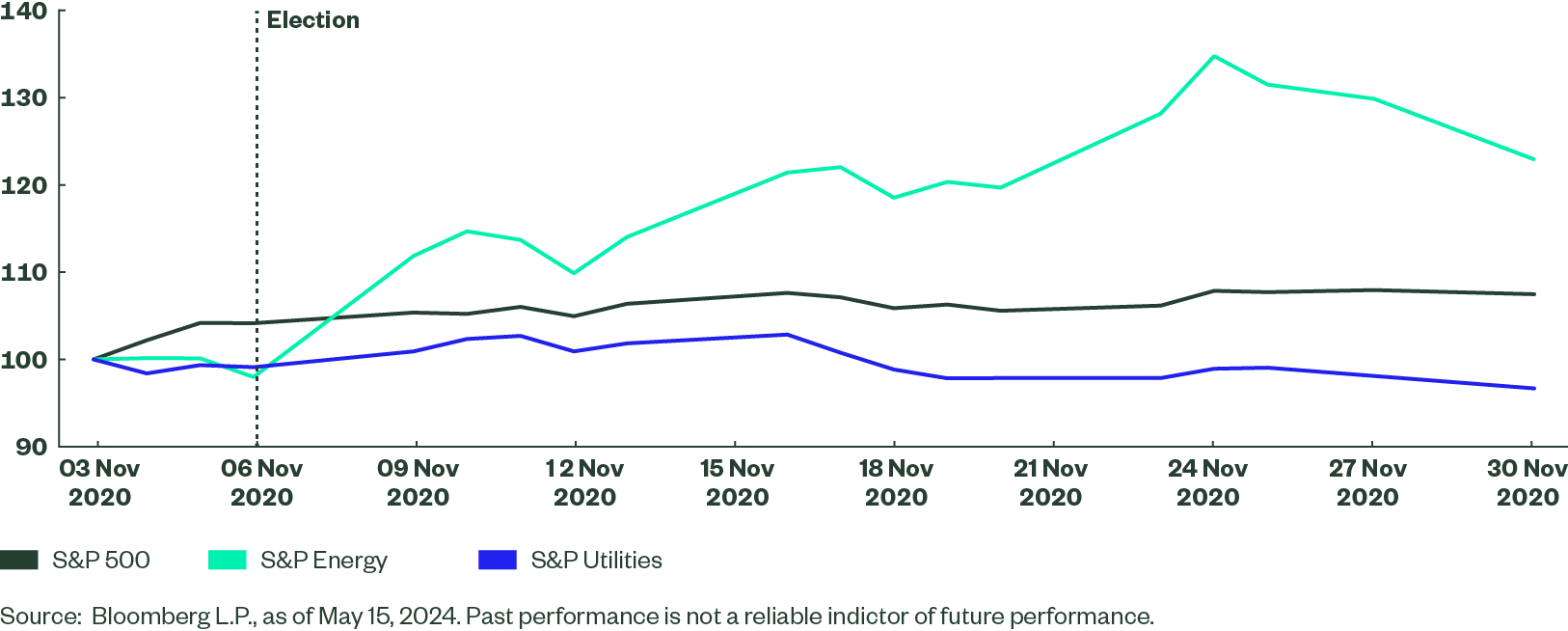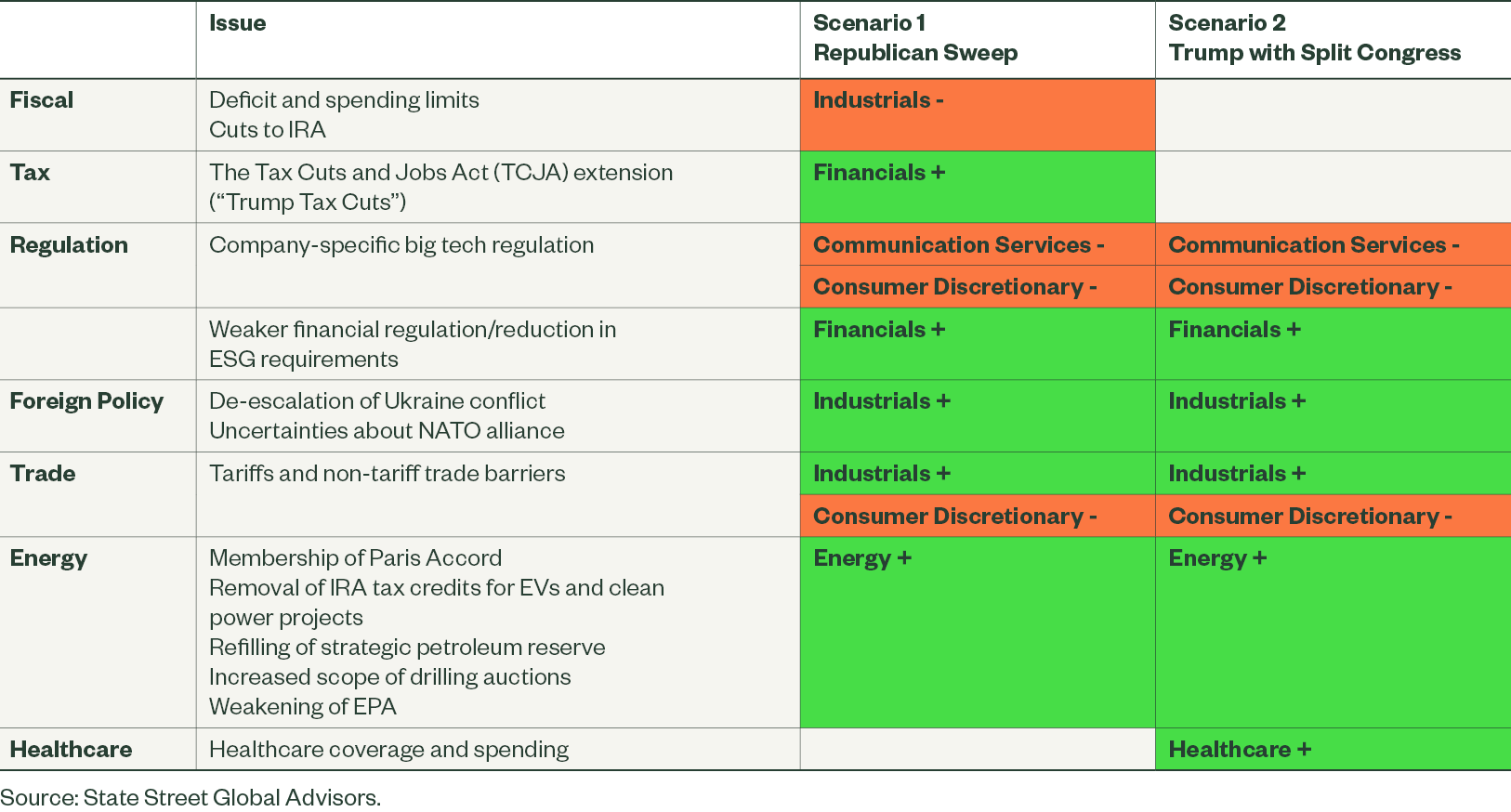Elections and Equities: The Impact of the US Election on Sector Investing
As the US election draws closer, greater investor attention is warranted on how to align market views with the potential November outcome. In this article, we consider which equity sectors could benefit or lose out depending on the election results.
In the third piece in our US elections series, we focus on which areas of the economy and industry are likely to be impacted by policy risks associated with each party’s campaign platform. Sector investing has historically been a key way for investors to reflect their views on the policies and who they consider most likely to win. Sector ETFs were a popular tool both during and after the US presidential election in 2016 and 2020. While we expect narrower levels of sector return dispersion this year, we still believe they offer opportunities to adapt portfolios to the election outcome.
The projected outcome remains very close. Our own election dashboard (composed of macroeconomic data, demographic compositional changes, post-2020 election trends, political fundamentals, fundraising patterns, among other factors) signals near-even probabilities in the presidential race; a virtually certain Republican takeover of the Senate; and a House of Representatives race which modestly favors a Democratic majority.
Since 1960, as Figure 1 illustrates, the policy swings have delivered an election year pattern where an uncertainty risk premium presents itself in the second quarter before then closing nearer the election day. It is true that investors typically increase their equity exposure after the event, and often in a pro-cyclical manner. Nonetheless, we expect investors will attempt to ‘play the election’ ahead of November 5 and we expect high trading volumes in sector ETFs through the coming months.
This would be a change from ETF flows which have predominantly favored broad-based equity indices (such as MSCI World) rather than sectors, factors or individual countries for over a year. The reason: sector returns, on average, have varied more in election years than in non-election years — and that has increased in the month of November.
Figure 1: Policy Swing Patterns in Risk Premia (1960 – 2020)

Sector Investing During Past Elections
The 2016 election is a good example of diverse returns. Despite the S&P 500 Index rising just 3% in November post-election, the surprise Trump win prompted a big dispersion between sector returns, as shown in Figure 2. There was a 17% difference in net returns between the best-performing US sector (Financials) and the worst-performing (Utilities) after polling day. Both sectors are heavily regulated and Financials, dominated by banks, benefitted disproportionately from expectations of deregulation. Notably, the overall Index only illustrated a conventional relief rally post-election.
Figure 2: Best and Worst Performing US Sectors Post-election, November 2016

In 2020, there was significant sector volatility earlier in the year in the run-up to the election, a period still recovering from COVID-induced lows, but only one sector stood out afterwards. Following the election, S&P 500 Index returns rose 8% through the end of November. Energy stocks jumped, with net returns 27% ahead of the weakest sector, Utilities, as hopes of Biden’s renewables agenda unwound.
Figure 3: Best and Worst Performing US Sector Post-election, November 2020

Looking back at the views we expressed ahead of the 2020 presidential election, we believed that there could be significant winners from Biden’s public investment plans. US infrastructure was underfunded and there were calls for fiscal spending to boost demand across the economy. Since then, the Biden administration has introduced three significant acts of legislation which have stimulated demand across transport, healthcare, utilities, and green energy, alongside securing and domesticating of the semiconductor supply chain. The sector to benefit most from this change of political priorities has been Industrials.
Sector Considerations in the 2024 Election
We identify three core scenarios that would impact policy and regulation in the aftermath of the election. Each has sectoral implications, though we recognize that the policy and regulatory gap is smaller in 2024 than in 2020 and that the incoming government will also face more policy constraints.
The three scenarios are:
- A Republican sweep with full Republican control of all branches of the federal government.
- A Trump victory with a split Congress where the Democrats control the House and the Republicans have a majority in the Senate.
- A Biden victory with a split Congress as in scenario 2.
Scenario 1 parallels the one in 2016, but under different circumstances. Lower starting tax rates, a much higher fiscal deficit, as well as higher bond yields, necessitate a different market response to fiscal expansion. We would expect any equity market rally to be relatively narrow and short-lived, depending on the extent of bond market response and an expected rise in longer-term yields. However, there would be sectors that would enjoy regulatory and even fiscal tailwinds.
Scenario 2 would include the same regulatory stimulus but the fiscal picture in our view would be diluted. Neither of these tailwinds are present in scenario 3 where President Biden remains in office. In this case, we expect few new regulatory initiatives and limited change in the fiscal trajectory.
In Figure 3, we outline the sectoral impact of scenarios 1 and 2 only, given the likelihood of relatively little change in Biden if reelected.
Figure 4: Sector Impact From Election Outcome

Sector Specific Rationales
Fiscal/Tax: Inflation Revival?
A Republican sweep could imply wider fiscal deficits with higher rates and a stronger US dollar, with the risk of slower trend growth. Furthermore, the likelihood of higher tariffs, particularly on Chinese goods being imported into the US, and the potential knock-on impact on prices means that higher inflation is back on the agenda.
The IRA, together with the CHIPS Act and Infrastructure Investment and Jobs Act, have supplied tremendous impetus for US-based transport, construction, and engineering companies in Industrials. This remains a key sector for us but is dependent on the extent of rollback under a Republican administration. While Republicans have argued about the high costs of implementation, many of the projects are popular at a state level.
In contrast to 2016, the tax burden would only drop marginally so the fiscal expansion would be less supportive for the equity marke
Regulation: Who Benefits and Who Is at Risk?
A wave of deregulation could be beneficial to Financials, particularly banks, but it would likely be smaller than in the previous Trump administration. The failure of five small- midsized banks last year could limit the appetite for deregulation. In the event of a Trump election victory, we would expect higher rates and a steeper yield curve, traditionally helpful to bank margins, albeit this could be offset by slower loan growth and higher delinquencies for banks.
One area certain to change would be the ESG framework, with fewer requirements on carbon footprint reporting and limits on the investment industry to develop and market ESG products. This would further widen the operational remits between US and European asset managers.
More regulation on Big Tech, particularly given the accelerating evolution of artificial intelligence (AI) and its potential scope and the consternation over social media, can be expected whoever wins the election. The planned TikTok ban is the first meaningful legislation imposed on the industry, and additional regulation is on the cards. However, under Trump we could see more targeted actions, with Meta and Amazon considered to be most in the crosshairs.
So while leading tech/entertainment/communication providers continue to hold long-term investment attraction for their facilitation of AI and other new technologies, regulatory risks temper that appeal.
Foreign Policy: Re-armament Continues
We will examine the geopolitics implications in a forthcoming piece. However, it is suffice to reiterate at this point that a Trump presidency would reinforce G7 defense spending. In addition, Trump’s penchant for tariffs on capital goods and likely reshoring would also benefit the Industrials sector, particularly in the US.
Trade: What About the Geopolitics?
While tariff rises are likely either way, they could be more disorderly with Trump. Expectations of Trump 2.0 include the imposition of trade tariffs on Chinese goods, in particular, being imported into the US. Also at risk, given previous pronouncements, are supplies of aluminum and steel, as well as car and auto parts from Mexico and elsewhere. Costs would likely rise for auto and consumer goods manufacturers, as well as for construction companies.
There are two significant conflicts already destabilizing commodities markets and threatening supply chains. If more threats emerge, companies may hasten efforts started during the pandemic to reshore more activities. This could benefit companies offering logistics expertise and consultants within the Industrials sector. As with tariffs, this could have a broad impact on US inflation.
Energy: Moving Closer or Further Away From Transition?
The set of issues grouped under Energy, including environmental or clean energy policy, is likely the most disruptive. Potential Republican actions could see the extension of fossil fuel operations and a pullback on environmental regulation. Any expansion in the size and scope of drilling auctions would be relevant to the oil and gas majors, and would likely see the US cement its position as the world’s largest producer of crude oil. Energy is an attractive sector for investors currently, given tailwinds from both a geopolitical angle and the possibility of higher-for-longer inflation. There has been progress towards transition in recent years, but any extension in the life of fossil fuels could drive an increase in valuations.
Conversely, this scenario could prompt investors to reduce exposure to Utilities, as home to some renewables companies which may find themselves out of favor under a Republican-dominated executive. An interesting aside, would be the different administrations limits to building new data centres, the requirement for which is growing rapidly with AI-stimulated use, with upside for electricity demand.
Investors are currently focused on the durability of Inflation Reduction Act (IRA) subsidies and credits. In our view, a Trump administration would mainly undermine IRA provisions by reducing the incentives for the manufacturing and ownership of electric vehicles (EV), and for the necessary infrastructure, while maintaining most of the other features. This would negatively impact component manufacturers and charging station suppliers, the largest of which is Tesla. The latter’s recent withdrawal from the charging market could also be understood in anticipation of this policy risk. Auto companies (14% of the S&P 500 Consumer Discretionary sector, including General Motors and Ford) would also be hit given that EVs have been a growth segment.
Healthcare: Less to Play Than Usual
It is not a healthcare-focused election – but the system is highly politicized, and post-Covid healthcare issues may still appear alongside abortion rights. We do not expect the Affordable Care Act to be meaningfully reformed given its huge popularity, though it could be restricted if Republicans control Congress. A remaining risk for pharmaceutical companies lies in attempts to reduce prescription drug prices under the IRA. This risk is more pronounced under a Biden re-election scenario, but we discount the odds. Hence, we believe the Healthcare sector will be relatively unaffected by the election and offers a good defensive position with improving earnings momentum.
The Bottom Line
Identifying sectors that are most likely to benefit from the election outcome is difficult in a tight race, but as we have highlighted in this article specific sectors are more sensitive than others to potential change. While Financials including banks could gain from deregulation, some parts of the Communication Services sector in particular, face the prospect of tighter regulatory scrutiny. And while potentially more and higher trade tariffs carry opportunity for domestic manufacturers, the risk of resultant higher inflation and high interest rates carry a threat. As we get closer to November, investors may increasingly implement views via sector allocations, in the US and internationally, in order to minimize potential risks and take advantage of any opportunity that might arise.